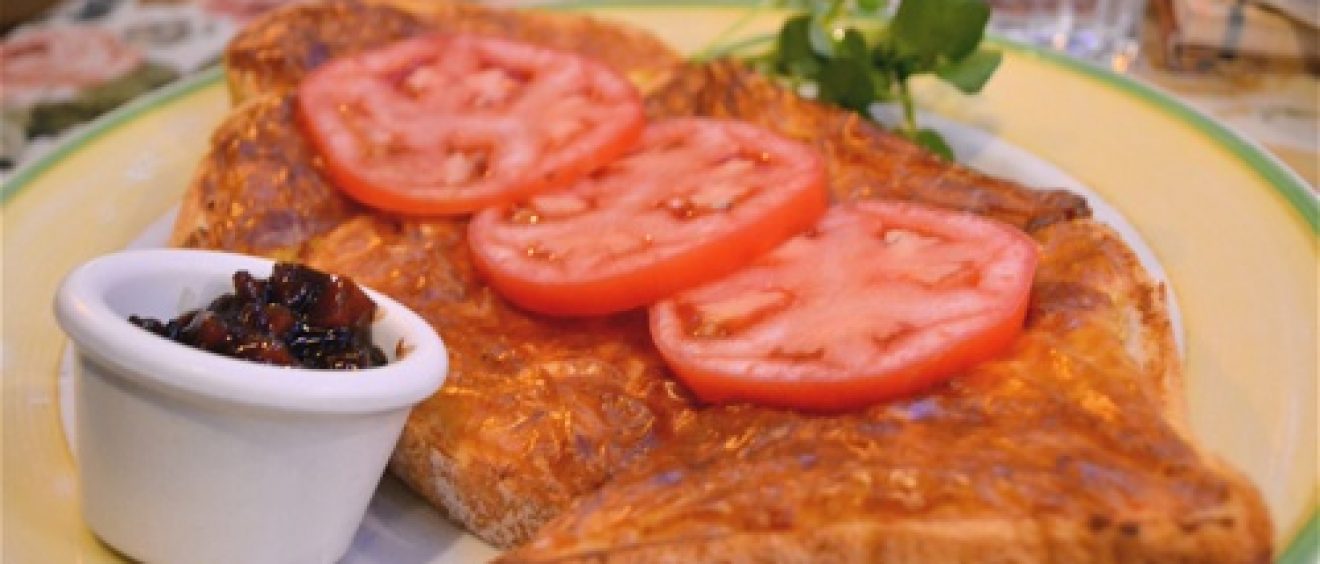
Search for the Holy Broil: Welsh Rarebit
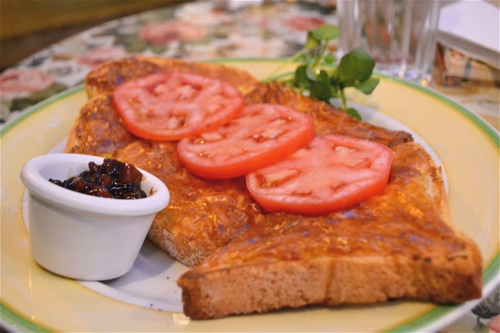
Editor’s Note: Brooklyn resident, food writer and Serious Eats vet Hannah Smith-Drelich hops over to ES this week to answer a vexing food mystery — just what the eff is Welsh rarebit?
Welsh rarebit is a great thing. Its name conjures wet gloomy mountains and smokey cabins full of hunched, hairy people. At least, that’s what Wales looks like in my imagination. And Scotland, too. But apparently, Welsh rarebit doesn’t have that nostalgic throw-back effect (remember the good old Celtic days?) on everybody.
“It’s steak, right?” said one of my friends, suddenly concerned that maybe it wasn’t.
“I thought it was rabbit,” said another with barely-concealed disgust. She owned a pet bunny.
Welsh Rarebit is neither steak nor rabbit. In fact, it’s not even Welsh rarebit. The correct term is Welsh rabbit, which makes sense only when you put it into the context of the English making fun of the Welsh, which they did even back when everybody wore furs non-ironically. Welsh rabbit, at its simplest, is cheese on toast. The Welsh were notoriously fond of their cheese, and back in the 1700s they were also notoriously short on meat: hence, their version of rabbit was cheese on toast.
This tricky bit of linguistic mockery was ruined in 1785, when Francis Grose identified ‘rabbit’ with ‘rarebit’ in a document oddly titled A Classical Dictionary of the Vulgar Tongue. Word historians have had their knickers in a twist ever since (especially the folks at Merriam-Webster), as ‘rarebit’ exists nowhere else as an independent word. Eccentric grammarian W.H. Fowler wrote in his 1926 Dictionary of Modern English Usage: “Welsh Rabbit is amusing and right. Welsh Rarebit is stupid and wrong.”
Any way you slice it, this is not your average grilled cheese. Nor any dolled-up croque monsieur, for that matter. Welsh rarebit is, essentially, a fondue. Except instead of wine, there’s beer; instead of tiny Frenchy forks, there’s a thick hunk of bread foundering under the oozy weight of melted cheese. (Flash back to fur-wearing men hulking by a campfire.) Cheddar is most commonly used in recipes today, along with dried mustard, cream or milk, and Worcestershire sauce. In some British restaurants the dish is accompanied by something called Branston pickle.
“What is that?” I asked my waitress at Tea & Sympathy, a very British restaurant in Manhattan.
“That, love, is Branston pickle.”
The waitresses all seemed to be very legitimate Brits—not even the best unemployed actress could pull of that whole English air. I repeated myself, louder, in case she couldn’t understand my thick American drawl.
“It’s pickle. In a brown sauce,” she explained. Sometimes it’s hard to communicate across cultures.
Branston pickle is a form of chutney, made from a tart sauce (think Worcestershire plus vinegar) with chunks of carrots, cauliflower, and gherkin. It has a nice pucker, and can cut across the wide expanses of cheese if you start to feel a bit woozy.
Speaking of wide expanses, I pounded the pavement over New York and Brooklyn last week to find the best Welsh rabbit in the area. Of course, since everyone seems to have taken their cues from A Classical Dictionary of the Vulgar Tongue, Welsh rabbit is completely absent from all menus—only the “stupid and wrong” rarebit remains.
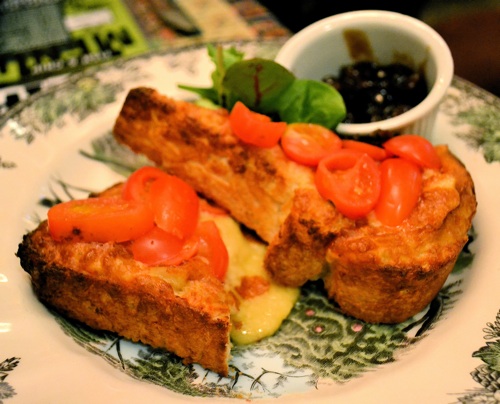
Sweet Melissa Patisserie in Cobble Hill has a nice crusty rarebit, with ample topping and a well-oiled salad, but I was left wanting ever more cheese. And while Tea & Sympathy was delightfully frilly and accent-filled, I prefered the rarebit at Park Slope’s Chip Shop (above). The toast was pliable and feathery, and my cheese had blistery brown skin that split in Cheddary excess. Note the puddle in the picture: in an ideal world, that plate would be all puddle.
At the Bourgeois Pig on the LES, the doorman looks straight out of Dickens and the rarebit is served in fondue form. The mixture is thick, heady, and potent, with bits of crushed garlic floating in it. But its little clay pot is lit by a candle, and the forks are slim and elegant. Which is completely wrong, since this dish should be all about hairy, Welsh, non-rabbits.
I would be loathe to finish this article without mentioning the iconic Stouffer’s frozen version. It comes in one of those plastic-roofed black trays, which can be microwaved and instantly spreadable in just a few minutes. I couldn’t tell you honestly if it tastes good; for me it’s a childhood-inducing madeleine, reminiscent of snow days and mittens burning on the radiator. It is uncontestably easy, easier than securing a recipe from a British waitress or getting a table of eight past a Dickensian doorman. Ten times easier than cooking Welsh rabbit traditionally, with a real fire and a cauldron of heated beer.
In the old days, bold Welsh-people used salamanders to broil things, back when a salamander was not a mini super-oven or a mutant-prone amphibian, but a formidable iron weapon. That’s what happens when you beat your swords into plowshares and then into kitchen utensils. It’s probably a good thing we didn’t have one of those lurking around the house when I was little. But really, there couldn’t be a more well-named thing for cooking Welsh rabbit. You put the rabbit into the salamander (take that food chain!) and the thing toasts your cheese to a nice bubbly brown, while you pull your fur cape closer, and stare out at the gloomy Welsh mountains, contemplating your next quest.

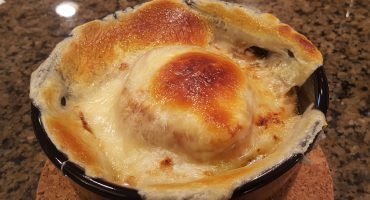
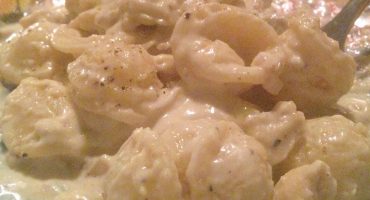
You’ve captured the essence of Welsh Rarebit perfectly, even now the English mock the Welsh, even now in our ironic furs. I think the Welsh Rarebit is the only good thing to come out of Wales.
I grew up on grilled cheese but in my early teens discovered this sophisticated alternative, actually in the form of a topping on a steak- the restaurant calling it a “Welsh Dragon”. From then I made this at any given opportunity.
For those wanting Branston Pickle, in DC you can occasionally find it at Eamonn’s in Old Town or at your local World Market.
Thanks for the trip down memory lane…
weird, i always thought it was some kind of salad.
That’s SO not true it’s the only good thing out of Wales.
There’s Ryan Giggs as well.
Your post was interesting to me because we have a family friend who talks about eating rabbit cooked in a special way in Wales.
Had never read a detailed account or background about it but now it is clear why this dish is special to “Welsh cooking” lovers.
Very informative post. Your photos are really good.
Thank you for insights,
TheGourmetCoffeeGuy
http://www.ourgourmetcoffee.com
The General Greene in Fort Greene has Welsh rarebit. Made with Cabot cloth bound aged cheddar.